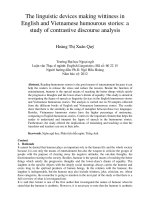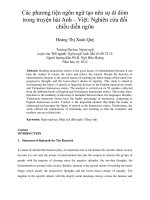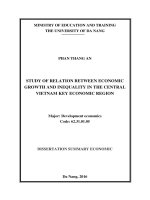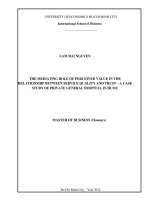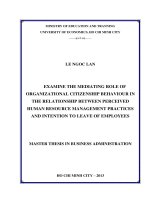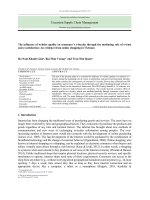The mediating role of relationship quality in the relation between relationship benefits and word of mouth a study of the airlines ticket service
Bạn đang xem bản rút gọn của tài liệu. Xem và tải ngay bản đầy đủ của tài liệu tại đây (1.04 MB, 88 trang )
MINISTRY OF EDUCATION AND TRAINING
UNIVERSITY OF ECONOMICS HO CHI MINH CITY
------------
PHAM VO THANH DIEP
THE MEDIATING ROLE OF RELATIONSHIP QUALITY IN
THE RELATION BETWEEN RELATIONSHIP BENEFITS
AND WORD OF MOUTH: A STUDY OF THE AIRLINES
TICKET SERVICE
THESIS OF MASTER OF BUSINESS ADMINISTRATION
HO CHI MINH CITY – 2012
MINISTRY OF EDUCATION AND TRAINING
UNIVERSITY OF ECONOMICS HO CHI MINH CITY
------------
PHAM VO THANH DIEP
THE MEDIATING ROLE OF RELATIONSHIP QUALITY IN
THE RELATION BETWEEN RELATIONSHIP BENEFITS
AND WORD OF MOUTH: A STUDY OF THE AIRLINES
TICKET SERVICE
Subject: Master of Business Administration
Code: 60340102
THESIS OF MASTER OF BUSINESS ADMINISTRATION
SUPERVISOR:
Assoc. Prof. Dr. Nguyen Dinh Tho
HO CHI MINH CITY – 2012
I
ACKNOWLEDGEMENT
First of all, I would like to express my most sincere gratitude to Assoc. Prof.
Dr. Nguyen Dinh Tho, my thesis supervisor. Without his invaluable advice,
patience and guidance, I would not have reached my final results.
Secondly, thanks to respectful lecturers of University of Economics Ho Chi Minh
City and all members of eMBA class course 19 have supported me in enhancing
knowledge during the master of business administration course.
Thirdly, I would like to thank the participants who had taken their precious
time to answer the questionnaires. This thesis would not have been feasible
without their valuable and honest feedback.
Last but not least, special thanks and love to my husband who is also my eMBA
classmate, Nguyen Van Thanh, for his useful discussions and advices while
implementing this thesis. At the same time, deepest thanks to other eMBA
classmates and my two close friends for their voluntary and enthusiastic supports
and kindnesses.
Pham Vo Thanh Diep
Ho Chi Minh City, October 2012
II
COMMITMENT
I would like to commit that this study, “The mediating role of relationship quality in
the relation between relationship benefits and word of mouth: a case study of
Vietnamese airlines ticket service”, has been implemented based on my
independent and serious studies and scientific researches. The data were collected
from reality and they had credible origins. The thesis supported the rule of antiplagiarism.
Pham Vo Thanh Diep
III
TABLE OF CONTENTS
ACKNOWLEDGEMENT..................................................................................... I
COMMITMENT .................................................................................................. II
COMMITMENT .................................................................................................. II
TABLE OF CONTENTS ................................................................................... III
LIST OF ABRREVIATIONS ............................................................................ VI
LIST OF TABLES............................................................................................. VII
LIST OF FIGURES ......................................................................................... VIII
ABTRAST .............................................................................................................. 1
CHAPTER 1: INTRODUCTION ......................................................................... 2
1.1 Research background: ....................................................................................... 2
1.2 Vietnamese aviation market:.............................................................................. 4
1.3 Problem statement: ........................................................................................... 5
1.4 Research Objectives: ........................................................................................ 7
1.5 Research question: ............................................................................................ 7
1.6 Scope and methodology of study: ..................................................................... 7
1.7 Practical significances of the study: .................................................................. 8
1.8 Structure of the thesis ........................................................................................ 8
CHAPTER 2: LITERATURE REVIEW ........................................................... 10
2.1 Relationship quality & relationship benefits: ................................................... 10
2.2 Relationship quality and word of mouth: ........................................................ 14
2.3. Proposed conceptual model: ........................................................................... 17
2.4. Summary ........................................................................................................ 18
CHAPTER 3: METHODOLOGY ...................................................................... 20
3.1 Research design: .............................................................................................. 20
3.1.1 Qualitative research: ................................................................................. 20
3.1.2. Quantitative research: .............................................................................. 21
3.2. Questionnaire design: ..................................................................................... 21
3.2.1 Measurement scales: ................................................................................. 21
IV
3.2.2 Questionnaire development: ..................................................................... 23
3.3 Sample Design:............................................................................................... 24
3.4 Methods of data analysis:................................................................................ 25
3.5 Research Process: ........................................................................................... 25
3.6 Summary: ....................................................................................................... 27
CHAPTER 4: DATA ANALYSIS AND FINDINGS ......................................... 28
4.1 Descriptions of sample .................................................................................... 28
4.2 Reliability and validity of the measurement scale ........................................... 29
4.2.1 Reliability (Cronbach alpha) ..................................................................... 29
4.2.2. Exploratory factor analysis (EFA) ........................................................... 32
4.3 Testing the research model and the hypotheses ................................................ 36
4.3.1. Testing correlations of constructs: ........................................................... 36
4.3.2. Multiple linear regression analysis of relationship quality scale: ............. 37
4.3.3. Simple liner regression analysis: ............................................................. 41
4.3.3 Summary of Liner regression analysis: .................................................... 42
4.4 Summary ......................................................................................................... 44
CHAPTER 5: CONCLUSION AND IMPLICATIONS .................................... 45
5.1 Discussion ....................................................................................................... 45
5.2. Practical implications...................................................................................... 46
5.3. Limitations and further research ..................................................................... 47
REFERENCES .................................................................................................... 49
APPENDIX 1: INITIAL MEASUREMENT SCALE ........................................ 53
APPENDIX 2: QUALITATIVE RESEARCH ................................................... 55
APPENDIX 3: VIETNAMESE QUESTIONNAIRE ......................................... 58
APPENDIX 4: CRONBACH ALPHA ANALYSIS ........................................... 62
Appendix 4.1: Confidence Benefits (CB) factor: ................................................... 62
Appendix 4.2: Special Treatment Benefits (ST) factor:.......................................... 63
Appendix 4.3: Social Benefits (SB) factor: ............................................................ 64
Appendix 4.4: Relationship Quality (RQ) factor: ................................................... 65
V
Appendix 4.5: Word of Mouth (WOM) factor: ...................................................... 66
APPENDIX 5: EXPLORATORY FACTOR ANALYSIS (EFA)...................... 67
Appendix 5.1: The EFA implementation of relationship quality scale: .................. 67
Appendix 5.2: The EFA implementation of word of mouth scale: ......................... 71
APPENDIX 6: CORRELATIONS ..................................................................... 72
APPENDIX 7: MULTIPLE LINER REGRESSION ANALYSIS .................... 73
Appendix 7.1: The result of multiple liner regression analysis: .............................. 73
Appendix 7.2: Testing assumptions ....................................................................... 74
APPENDIX 8: SIMPLE LINEAR REGRESSION ANALYSIS ....................... 76
Appendix 8.1: The result of simple liner regression analysis: ................................ 76
Appendix 8.2: Testing assumptions ....................................................................... 77
VI
LIST OF ABRREVIATIONS
CB: Confidence benefits
EFA: Explore factor analysis
IATA: International Air Transport Association
ICAO: International Civil Aviation Organization
MLR: Multiple linear regression
RQ: Relationship quality
SB: Social benefits
SLR: Simple linear regression
ST: Special treatment benefits
WOM: Word of mouth
VII
LIST OF TABLES
Table 3.1 The measurement scale of relationship benefits ..................................... 22
Table 3.2: The measurement scale of relationship quality ...................................... 23
Table 3.3: The measurement scale of word of mouth ............................................. 23
Table 4.1 Statistical report of demographic variables............................................. 29
Table 4.2 Cronbach alpha coefficients ................................................................... 31
Table 4.3 EFA results of relationship quality scale: ............................................... 34
Table 4.4 EFA results of word of mouth scale: ...................................................... 35
Table 4.5. Correlation matrix ................................................................................. 36
Table 4.6: ANOVA of MLR .................................................................................. 38
Table 4.7: MLR Model Summary .......................................................................... 38
Table 4.8: Coefficients of MLR ............................................................................. 39
Table 4.9: ANOVA of SLR ................................................................................... 41
Table 4.10: SLR Model Summary ......................................................................... 42
Table 4.11: Coefficients of SLR ............................................................................ 42
Table 4.11: Results of linear regression analysis .................................................... 42
VIII
LIST OF FIGURES
Figure 1.1 Degree of trust in forms of advertising.................................................... 2
Figure 2.1 Proposed conceptual model .................................................................. 18
Figure 3.1 Research process .................................................................................. 26
Figure 4.1. The revised research model ................................................................. 43
1
ABTRAST
This study examines the mediating role of relationship quality in the relations
between relationship benefits and word of mouth in Vietnamese airlines ticket
service.
The model tests the impact of relationship benefits, namely confidence benefits,
special treatment benefits as well as social benefits on relationship quality, and
relationship quality on word of mouth. The research was conducted with a sample
of 220 respondents using airline ticket service in the past six month in Binh Duong
province and Ho Chi Minh city. The result showed that relationship quality had a
significant impact on positive word of mouth. However, relationship quality was
affected by only two components of relationship benefits including confidence
benefits and social benefits, and was not explained by special treatment benefits.
These findings suggest that managers should concentrate on social benefits and
confidence benefits to enhance relationship quality. Thanks to the increase of
relationship quality, word of mouth will be enhanced.
2
Chapter 1: INTRODUCTION
1.1 Research background:
In an environment that customers almost decrease their beliefs in advertisements by
organizations, word of mouth becomes significantly effective to the competition of
company’s advantage (International Word of Mouth Marketing Conference, 2005).
Besides, the Nielsen Global Online Consumer Survey over 25,000 online
consumers from 50 countries in 2009 showed that the information from
acquaintances and comments from online customers are the most reliable
advertising form.
Figure 1.1 Degree of trust in forms of advertising
The report also shows that ninety percent of surveyed consumers trust in the
recommendations from people and seventy percent believe in the information
3
posted by online consumers, meaning consumers’ reliance on word of mouth in the
decision-making process, either from their acquaintances or online consumers
whom they have not known, has increased significantly.
The power of word of mouth is proved and recognized by plenty of previous
researches. Clearly, its power is an extreme influence, because word of mouth
appears as a naturally and normally colloquial situation, it happens any time of
day (Gildin et al., 2003). Moreover, its characteristics is spontaneous and
independent from any seller (Gildin, 2003), which strongly explains the major
reason why
word of mouth can influent people’s buying behaviors and final
purchase decisions (Kiecker and Cowles, 2001; Buttle, 1998; Bayus, 1985). It
also means that WOM
acts as a
source
of
information as well as a
persuasive communication tool (Schindler and Bickart, 2005; Gildin, 2002;
Keller, 2007; Bayus, 1985).
In addition with attracting new customers, word of mouth is important for the long
term economic success of company (Hennig-Thurau et al., 2002).
It also
contributes to decrease the cognitive dissonance of existing customers
(Wangenheim, 2005). Cognitive dissonance, experienced by individuals, is even
over the concern of having made a wrong decision (Festinger, 1957). Accordingly,
spreading word of mouth, customers attempt to convince themselves of the
purchase decision they made (Wangenheim, 2005). Obviously, customers use
WOM as one of the strategies to reduce their post-decision dissonance (Festinger,
1957).
According to Buttle (1998), WOM can be regarded as a risk reduction strategy.
Dichter (1966) proves customers’ purchase-intentions for innovative products are
increased by positive word of mouth because of reducing the risk associated
acquisitions. Garbarino and Strahilevitz (2004) also cite the reduction in perceived
risk when purchasing online after receiving a site recommendation from friends.
4
Additionally, customers believe heavily on the advices and suggestions of whose
have experienced the service (Kinard and Capella, 2006). Furthermore, consumers
often trust each other more than their communications with firms, thus emphasize
the importance of WOM (Zeithaml and Bitner, 1996).
Despite numerous literatures about the importance of WOM, there is only few
seldom researches analyzing about the antecedents of WOM and specifically the
impact of customer-employee relationships on WOM intentions (Gremler et al.,
2001).
1.2 Vietnamese aviation market:
Aviation industry has made significant contributions in promoting economic
development, increasing foreign currency income, improving the balance of
payments, expanding the exchange of goods and cultures, as well as promoting
Vietnamese image to the world. Therefore, the Government has confirmed that
Vietnam's aviation industry is a key economic sector and promoted investment in
modernizing and enhancing the service quality of this industry. Vietnam has the
advantage of strategic location (in the Asia-Pacific region) which accounts for 50%
of the volume of air transport worldwide (Ministry of transport – middle airports
corporation, 2010).
According International Civil Aviation Organization (ICAO) at Montreal in July
2012 assumed that civil aviation activities in Asia-Pacific was the most effective
with net income of nearly U.S. $ 11 billion, while the net profit of the European
airlines achieved less than U.S. $ 1 billion, and African airlines lost $ 100 million.
ICAO also forecasted that global aviation industry continues to grow 5.4% in 2012
and in coming the years to come with the speed of 6% in 2013 and 6.4% in 2014.).
This is an advantage information for the development of the world's aviation
industry in general and Vietnam in particular so far.
5
For Vietnamese aviation, the report of Vietnamese General Statistics Office
indicated that in the first quarter of 2012, the number of air passengers has
increased proximately 4.4% compared with the same period in last year.
Based on the Investment newspaper, the International Air Transport Association
(IATA) forecast that in 2014, Vietnam will become the third fastest growing market
of passenger and international merchandise transport in the word, only behind
China and Brazil.
By 2015, the Vietnamese aviation market will have 34 - 36 million passengers; by
2019, it will reach 52-59 million passengers. Besides, the freight will increase to
850,000 - 930,000 tons in 2015 and from 1.4 to 1.6 million tons in 2019.
With all above information, Vietnamese aviation promises a huge potential for
development. In other words, it is a big chance for airline ticket agents in their
business.
1.3 Problem statement:
Airline ticket agents are considered as the airline representatives to make
reservations and sell tickets. Airline ticket agents hold stressful duties, because they
relate directly to customers and timely solve their travel problems. Moreover,
sometimes, they also put up with many complaints which are actually not their
faults, such as the flight delays or cancellations,… Due to the unexpected problems
of the flight at any time, airline ticket agents must work at nights, weekends, or
even on holidays.
Besides the work pressure, the airline ticket agents also face against strong intensity
of competitive pressure from the others airline ticket agents and, even from the
airlines head offices. The pace among agencies lies on the race of marketing
campaigns, customer services, sales strategies… To stand out from the rest, airline
ticket agencies try to have super offers or policies. For example, they try to post
6
more online ads, make more cold calls, provide 24/24 online support, free ticket
delivery, convenient payment method,… Interesting enough, often know as
agencies’ supplier and supporter, the airline head offices are also strong competitors
to agencies. The types of this challenge are not only low commission but also
airlines’ official websites. Airlines tend to gradually decrease agents’ commission
to increase their competitive advantages in the growth of low cost carries; another
way is to reduce their dependence on agents by using their direct website. The
website supplies flights information and itineraries which enable customers to easily
make reservation directly.
To overcome above challenges, it leads to the thirst of seeking a wise advertising
method to survive agents’ business. This best choice has to be low in cost, and
enable airline ticket agents to not only take care of the existing customer
relationships but attract new customers also.
How effective is the positive WOM method to make customers change a brand, an
agent or customers attitudes? WOM is much more effective than other ways. First,
to affect brand switching, it is seven times over the printing, quadruple direct sales,
and double broadcast channel (Katz and Lazasfeld, 1955). Secondly, to create
customer’s positive attitude, Day (1971) indicated that WOM is nine times
productive, while Mangold(1987) defines it as five times.
According to Zeithaml et al. (1985), word of mouth is the most effective mean to
convey information, and even more important to the services sector. Indeed, even
Philip Kotler (2007) also assumes that service buyers tend to rely more on word of
mouth than on advertising when selecting a provider.
Thus, analyzing and identifying factors influent the positive word of mouth is
essential for airline ticket agents. Based on my best knowledge, there is no study
about this in Vietnam yet.
7
1.4 Research Objectives:
The overall objective of this thesis is to examine the mediating role of relationship
quality in the relations between relationship benefits and word of mouth.
Specifically:
1. The relationship between confidence benefits and relationship quality.
2. The relationship between special treatment benefits and relationship quality.
3. The relationship between social benefits and relationship quality.
4. The relations between relationship Quality and word of mouth
1.5 Research question:
This research aims to answer the following questions:
- Do confidence benefits affect to relationship quality?
- Do special treatment benefits impact on relationship quality?
- Do social benefits impact on relationship quality?
- Does relationship quality impact on word of mouth?
1.6 Scope and methodology of study:
The study would focus on positive word of mouth when customers directly buy
airline ticket. Furthermore, to ensure the adequate information for the study, the
surveyed candidates will be selected, including only customers directly buying and
using airline ticket service in the past 6 months, their family members and people
who don’t work in the airlines or airline ticket agents... The study is conducted in
Binh Duong and Ho Chi Minh City.
8
The study should be conducted through 2 main phases: (1) The qualitative research
is used to construct and improve the Vietnamese questionnaire. (2) The quantitative
research is used to collect, analyze survey data as well as estimate and test the
model. Specifically, the study uses the 11.5 SPSS software to analyze the reliability
and validity of measurements by Cronbach’s alpha coefficient and exploratory
factor analysis (EFA); and test the model as well as hypothesis through the
regression analysis.
1.7 Practical significances of the study:
The research provides information and scientific arguments to support airline ticket
service providers to enhance the quality of relationship with customers, through the
suitable selection of essential benefits brought for customers. It helps reduce costs
and increase efficient business. Furthermore, the research also shows the important
role of word of mouth in business.
Specifically, the study indicates the relations between relationship benefits
constructs and relationship quality and between relationship quality and word of
mouth.
The study also contributes the theories related to word of mouth in the airline ticket
service in Vietnamese context.
In short, the study has a practical significance for individuals or enterprises that care
for or related to airline ticket service.
1.8 Structure of the thesis
Chapter 1: Introduction
This chapter presents a background of the important role of word of mouth and
Vietnamese aviation industry. Introduction chapter will also provide problem
statement, the research questions, research objectives, scope and methodology of
9
the study as well as practical significances of the study.
Chapter 2: Literature review and proposed research model
This chapter presents that an extensive literature review assess different
measurements of relationship quality as well as word of mouth. Subsequently, the
research framework and hypotheses will be proposed in this chapter.
Chapter 3: Research methodology
This chapter presents the methodology of empirical study.
Chapter 4: Data analysis and results
This chapter presents the analysis of gathered data which to test the hypotheses and
answer the research questions.
Chapter 5: Conclusions and implications
This chapter will present implications of this study and will end the research with
limitation and suggestions for future research.
10
Chapter 2: LITERATURE REVIEW
This chapter presents that an extensive literature review assesses different
measurements of relationship quality as well as word of mouth. Subsequently, the
research framework and hypotheses will be proposed in this chapter.
2.1 Relationship quality & relationship benefits:
2.1.1 Relationship quality:
Conceptualizations of the relationship quality have been recommended in many past
studies. For example, Baker et al. (1999) indentified cooperation as a component of
relationship quality; meanwhile Dorschar et al. (1998) assumed that the dimensions
of relationship quality consist of orientation and opportunism. However, there has
been general agreement that the key elements of relationship quality are
satisfaction, commitment and trust (Dorsch et al., 1998; Smith, 1998; Baker et al.,
1999; De Wulf et al., 2001; Hennig-Thurau et al., 2002). Moreover, those three
components as measurements for relationship quality are more specific constructs
than the others, such as cooperative norms. This component is academically
conceptual distinct constructs, but consumers have problems in distinguishing them
and tend to “lump them together” (Crosby, Evans, & Cowles, 1990; De Wulf et al.,
2001). Furthermore, customers usually examine relationship quality in aspect of
trust, satisfaction, and commitment in service contexts (Crosby et al., 1990; HennigThurau et al., 2002; Caceres and Paparoidamis, 2007). For all these reasons, in this
study, trust, satisfaction and commitment are the most appropriate variables in
describing relationship quality measurements, which express the overall nature of
relationships between customers and service providers (Hennig-Thurau et al.,
2002).
11
2.1.2 Relationship benefits
According to Zineldin (2006), the relationship benefits offer consumers the value
beyond their expectations. Consequently, it can deeply impress them (Kinard and
Capella, 2006; Reynolds and Beatty, 1999). Moreover, it can affect or even control
the customers’ behaviors, such as their beliefs, loyalties, and commitments. This
influence has been proved by the research of Morgan and Hunt (1994), or HennigThurau et al. (2002). Both of these researches indicated that the more benefits
provided to the users, the more commitments the providers would receive.
Therefore, relationship benefits bring advantages to the customer-provider
relationships.
Thanks to its advantages, relationship benefits are said to add quality to the
relationship quality (Hennig-Thurau et al., 2002). Specifically, it creates a better
value perception, which is the key to open further relations (Blackwell et al., 1999;
Hennig-Thurau et al., 2002). This key brings in satisfaction and commitments, two
elements of a relation quality. In return, the relation quality coordinates the relations
between relationship benefits and WOM (Hennig-Thurau et al., 2002). The author
therefore comes to the conclusion that relationships contributes to the relationship
quality.
Based on Gwinner et al. (1998), relationship benefits include three dimensions of
benefits that are confidence, special treatment, and social benefits. Each of them
plays an important role in supplying the core value for customers.
Confidence benefits:
Confidence benefits have been found to be the most important components of all
relationship benefits (Berry, 1995; Bitner, 1995; Kinard and Capella, 2006).
According to Gwinner et al. (1998), confidence benefits is an aspect of customer’s
sense about less anxious and more comfortable in recognizing what to expect when
using service. Besides, confidence benefits eliminate risk and increase awareness of
12
expectations from service providers (Kinard and Capella, 2006). The more
confidence benefits customers perceive, the stronger feeling of security and comfort
in promoting relationship they have with service providers (Gwinner et al., 1998). It
likely leads to enhance the result of perception of relationship quality. Obviously,
Hennig-Thurau et al., (2002) found the positive relationship between confidence
benefits and one relationship quality variable – commitment. In the research of Kim
et al. (2006) in the restaurant industry suggest that overall customer confidence
enhances relationship quality. According to Patterson and Smith (2001), confidence
benefits express the customers’ desires in maintaining a sustainable relationship
with service providers and feeling confident in their core service supply. Thus, the
author hypothesizes that:
H1. Confidence benefits are positively related to relationship quality.
Special Treatment Benefits:
In all elements of relationship benefits, special treatment benefits are the most
tangible components that concern to monetary and non-monetary benefits offered
by a specific service firm as a result of the relationship between customers and
providers (Gwinner et al, 1998; Reynolds and Beatty, 1999; Patterson and Smith,
2001; Hennig-Thurau et al., 2002). This is special excess value, favor or advantage
offered beyond customer’s expectation (Gwinner et al, 1998; Reynolds and Beatty,
1999; Patterson and Smith, 2001; Hennig-Thurau et al., 2002). When the service
provider succeeds in providing special treatment benefit to its customer at high level
of face-to-face interaction, each customer is treated as a specialized segment (Dolen
et al., 2004), it may make the relationship quality better. This point is demonstrated
in many previous studies. Specially, special treatment benefits positively affect on
relationship components, namely satisfaction (Reynolds and Beatty, 1999) and
commitment (Hennig-Thurau et al., 2002). In addition, the research of Hyun (2010)
shows that tangible aspects of the service offered such as price breaks or quicker
services positively influence to relationship quality. Thus, it can be seen that special
13
treatment benefits and relationship quality has a positive relationship. Therefore, we
hypothesize that:
H2. Special treatment benefits are positively related to relationship quality.
Social benefits:
The second most important benefits to the customer are social benefits (Gwinner et
al., 1998). Social benefits are the benefits that customer receive thanks to the long term customers’ relationships with service providers such as being recognized by
employees of service firms, familiar with employees and developing a friendship
with service providers (Gwinner et al., 1998). In other words, social benefits are
quite natural emotion because they bases on the relationship between customers and
provider (Hennig-Thurau et al., 2002). This aspect may involve in strengthening
friendships among services employees and customers, knowing customer’s name,
and identifying customer preferences (Berry, 1995; Gwinner and Gremler, 2000).
Therefore, the raising of social benefits in relationship between customer and
providers will reinforce cooperation and develop the customers’ experience in
utilizing service (Bitner, 1995).
Commitment is seen as mediated factor in the relationship between social benefits
and WOM (Hennig-Thurau et al., 2002). Besides, personal interactions and
friendships between customers and employees have been proved as a factor to
enhance satisfaction levels (Price and Arnould, 1999; Gwinner and Gremler, 2000).
In addition, the results of previous research have showed that there exists the
positive relationship between social benefits and relationship quality constructs such
as commitment (Goodwin and Gremler, 1996; Goodwin, 1997) and customer
satisfaction with the service provider (Hennig-Thurau et al., 2002). Finally,
according to Bendapudi and Berry (1997), customers increase their trust levels
when they feel social bonds with employees. Thus, social benefits directly
positively affected relationship quality.
This connection is reaffirmed by the research of Kim et al. (2001), in which they
14
conclude that stronger social relationships with customers result in higher
relationship quality. This kind of bond is important enough to be equal to a business
relation (Crepiel, 1990). In the research of Gremler (2001), he even recommends
companies the attempts to have the tight relationships with customers. Kinard and
Capella, in their research 2006, support this point of view by stating the
unavoidable exist of communication in business and its influence on the
relationship quality. The above clues allow the author to reach the third hypothesis:
H3. Social benefits are positively related to relationship quality.
2.2 Relationship quality and word of mouth:
2.2.1 Word of mouth
There are many researches and definitions for word of mouth. One of the first
researchers to address WOM is Arndt (1967) who defined WOM as the
noncommercial communication between person to person that related to brand,
product or service. Some years later, Westbrook (1987) described WOM as
“informal communications directed at other consumers about the ownership, usage,
or characteristics of particular goods and services and/or their sellers”. Anderson
et al. (1998) defined word-of-mouth (WOM) as “an informal communication
between private parties in which products and services are evaluated”. Most
recently, East et al., (2008) assumed WOM as “informal advice passed between
consumers”. Also according to East et al., (2008), WOM is defined as “is usually
interact, swift and lacking in commercial bias”. As the above definitions, word of
mouth is considered as non-commercial exchange; hence most of the verbal acts are
originated from spontaneous senders, instead of sponsor (Stern et al, 1994).
Believing in its non-commercial purpose, the listeners take WOM as a true, reliable
and helpful source of information (Day, 1971; Murray, 1991). In compared with
common promoting, he stated that WOM could be nine times effectively turn
negative perception into positive ones. Same proof from the research of Murray
15
(1991), it shows that words from family, friends or colleagues are more favorably
received than commercial promotional resources. Shed (1971) emphasized the value
of WOM. In his research, WOM outweighed advertising in drawing customers’
attention and decision.
WOM impacts throughout the buying cycle. Since 1966, Britt has recorded this
impact from the base of Sociology. At the first stage, the WOM influence the phase
of attention, interest, expectation,… (Lynn, 1987; Stock and Zinsner, 1987;
Woodside et al., 1992; Webster, 1991; and Zeithaml et al, 1993). In the next stage,
WOM continues affecting the evaluation, conviction, desire… WOM has a role in
this phase thanks to the fact that people use WOM as their own information
resource, hence voluntarily grant it their trust (Murray, 1991). In the final stage,
buying or not, Magold (1987) proved that the influence of WOM is stronger than
the others’ one.
File et al. (1994) affirmed the impact of WOM to the business. Interesting enough,
this impact could be a double-edged sword, depending on the customers’
satisfaction level (Bolfing, 1989; Engel et al., 1969; Hartline and Jones, 1996;
Richins, 1983; Tybout et al., 1981; Westbrook, 1987). Together with product
performance, the satisfaction degree will directly decide the type of WOM (Singh
and Pandya, 1991; Tanner, 1996; Hartline and Jones, 1996). Beyond customer’s
expectation, it will be positive WOM, otherwise negative WOM (Singh and Pandya,
1991). The existence of these two kinds has been examined and proved in various
context, such as hospitality (Cadotte and Turgeon, 1988), purchasing (Swan and
Oliver, 1989), non-profit organization (Cermak et al., 1991), health service
(Headley and Miller, 1993),…
Ironically, listeners tend to be driven by the negative WOM rather than the positive
WOM (Arndt, 1967). Meanwhile, it should be noted that bad WOM spreads wider
and faster than good one. Here are the figures illustrating the dominance of negative
WOM. The rate of info transmission between negative WOM and positive WOM is
